A partnership to move fruit by rail has been going gangbusters this past year and is now sending about 800 refrigerated containers a month from Washington and Oregon to 19 eastern states and the Canadian province of Ontario–and it’s gearing up to do more.
Much of the cargo is produce, frozen and fresh, fruits and vegetables on 53-foot containers that can be placed on trucks and rail. Half of that is fruit moving from Quincy, Washington, and Portland, Oregon, to Chicago and then on to other destinations. The fruit includes pears and sweet cherries, but 80 percent of the fruit are apples. The Cold Train freight program is a partnership involving Burlington Northern Santa Fe, which provides the rail service; Rail Logistics, which provides the containers; and the Port of Quincy.
Patrick Boss, who works for the Port of Quincy and Rail Logistics-Cold Train, hopes the business boom will continue.
Some growth resulted from demand for Washington apples needed to replace nearly 40 million bushels eastern growers did not produce because of widespread freezes in the spring of 2012.
But the eastern apple crop this year is large and is just coming to market. Last year’s eastern crop failure opened markets for more than just fresh market apples packed in boxes. There was demand for apples to make juice and other processed products. “Before last year, western growers hadn’t really connected in a significant way with the juice and applesauce makers in the East,” Boss said.
No bins
“This year, they also found they could ship such apples in bulk. They were using potato pilers to load apples into containers,” he said. “This took bin weight out of the load and eliminated the need for bin return.” The containers each hold 42,500 pounds of cargo.
In September, Cold Train announced it was bumping up its fleet to more than 400 Hyundai 53-foot refrigerated containers, adding new destinations on the East Coast, and adding Toronto, Ontario, to its list.
In 2010, Rail Logistics, based in Overland Park, Kansas, started the Cold Train Express Intermodal Service in cooperation with the Port of Quincy and Burlington Northern Santa Fe Railroad.
The Cold Train part of the name refers to the sealed, refrigerated containers that are loaded with produce and hauled by semi trucks to be loaded, double deep, onto well cars that are then connected to a train. The “well” allows the containers to sit close to the rails and keep a low center of gravity when containers are stacked.
The Intermodal part of the name describes the integration of truck and rail. Since starting, Rail Logistics-Cold Train has developed agreements with four major railroad enterprisesBNSF, CSX, Norfolk Southern, and, most recently, Canadian National. The rail network connects to major cities, with trucks providing right-to-the-door pickup and delivery. Neither shippers nor receivers need to have rail sidings to use this rail service, Boss said.
On the truck side, Interstate Distributor Co. provides a dedicated fleet of trucks for short-haul drayage service for Cold Train to and from the Port of Quincy Intermodal Terminal in Washington State. C&K Trucking provides a dedicated truck fleet to Cold Train within a five-state radius of Chicago.
The Port of Quincy Intermodal Terminal began operating in 2002 with the intention of providing rail service from central Washington west to Seattle carrying fruit and other produce destined for export overseas, Boss said.
“It soon became evident that short-haul intermodal rail wasn’t practical or efficient. It took too long, so most produce shippers continued to truck product directly to the ports of Seattle and Tacoma,” he said.
While the Port of Quincy was trying to do westbound intermodal rail service for produce, there was an eastbound service out of Wenatchee from Amtrak called the Fruit Express. Amtrak put some specially designed refrigerated railcars on the back of its passenger trains for shipment of apples and other produce to the East Coast. Then Amtrak stopped the service.
In late 2007, Rail Logistics-Cold Train approached the Port of Quincy about doing an eastbound express refrigerated intermodal service out of Quincy.
“Given the previous success of Amtrak’s Fruit Express from Wenatchee, we thought that Cold Train’s proposal really had some merit,” Boss said. “Additionally, we learned that BNSF’s long-haul intermodal trains move very fast from Quincy to Chicago.”
Two-mile trains
Cold Train now moves produce on trains departing six days a week, arriving in Chicago in three to four days and the East Coast in six or seven. The refrigerated cars are monitored and temperature is controlled by satellite GPS, Boss said.
Cold Train is now delivering refrigerated cargo from Washington and Oregon to 19 statesIllinois, Indiana, Michigan, Wisconsin, Ohio, Pennsylvania, New York, New Jersey,Connecticut, Massachusetts,Delaware, Maryland, Virginia, North Carolina, South Carolina, Louisiana, Mississippi, Georgia, and Florida and to Toronto, Ontario.
In 2010, Cold Train shipped about 100 containers of perishable commodities per month from Washington State to the Midwest. In 2011, shipments increased to about 300 containers per month. In 2012, Cold Train was hauling more than 500 containers of fresh and frozen cargo per month. In 2013, Cold Train has been transporting nearly 700 containers per month from Quincy and Portland and expects to hit 1,000 shipments per month by the end of 2013. Potentially, Cold Train could handle 3,000 containers a month, says Steve Lawson, company president.
The Cold Train is part of a larger eastbound expedited train called the BNSF “Z” Train. This train originates in Seattle, filled with imported merchandise to be moved east. Typically, Boss said, the train leaving Seattle can’t be longer than 8,000 feet as it has to climb the steep grade over the Cascade Mountains through Stevens Pass and the Cascade Tunnel. Once in Quincy, it has capacity for about 2,000 more feet of rail cars, plenty of space available to the Cold Train.
The train moves at 80 to 90 miles an hour through much of the distance and never stops between Quincy and Chicago.
As BNSF owns these tracks, its trains hauling freight have priority and move much faster than passenger trains, Boss said. Trucks driven by teams of drivers can beat the train, but not by muchabout half a day earlier to Chicago. •

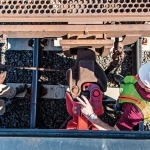
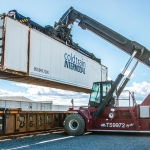
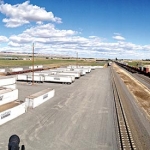

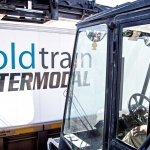
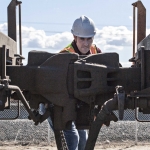
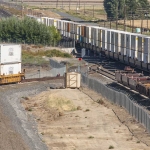
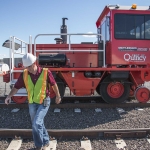
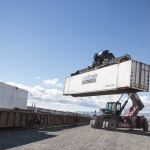

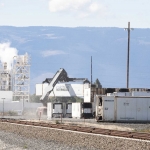
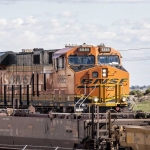
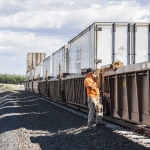
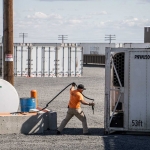
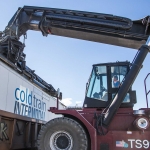
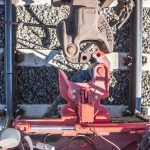
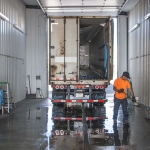





[…] https://goodfruit.com/the-cold-train/ […]